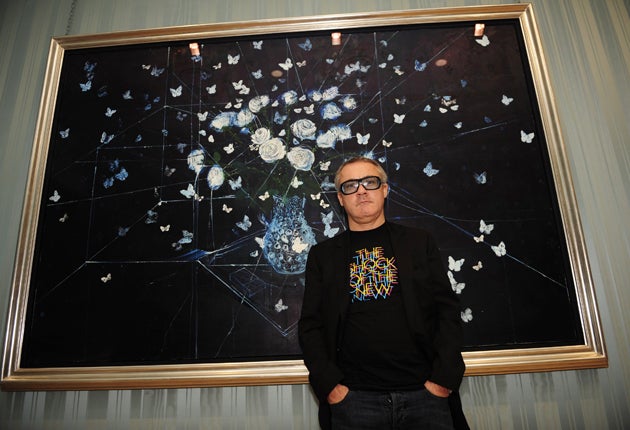Sex & Violence, Death & Silence, By Gordon Burn
Portraits of the artist as a hero – and a hustler

Your support helps us to tell the story
From reproductive rights to climate change to Big Tech, The Independent is on the ground when the story is developing. Whether it's investigating the financials of Elon Musk's pro-Trump PAC or producing our latest documentary, 'The A Word', which shines a light on the American women fighting for reproductive rights, we know how important it is to parse out the facts from the messaging.
At such a critical moment in US history, we need reporters on the ground. Your donation allows us to keep sending journalists to speak to both sides of the story.
The Independent is trusted by Americans across the entire political spectrum. And unlike many other quality news outlets, we choose not to lock Americans out of our reporting and analysis with paywalls. We believe quality journalism should be available to everyone, paid for by those who can afford it.
Your support makes all the difference.Gordon Burn was a one-off. The range of his interests and competence made him impossible to define. He was by turns a biographer of the Yorkshire Ripper and the Wests, a historian and analyst of sport, an original novelist, an enthusiast of poetry and a gifted journalist. It's as hard to find precursors for him (Hazlitt?) as to establish parallels. The qualities that mark out his writing are clarity, energy and an immediate grip on the reader's attention.
Burn, who died earlier this year, was also an art critic and, as this huge collection from more than three decades demonstrates, he gave this subject too the benefit of his insatiable curiosity and descriptive powers. That Burn finds something interesting is in itself a recommendation, perhaps especially to those who take a sceptical view of BritArt. Burn manifests a Geordie's suspicion of bullshit, so he would hardly be taken in by a chimera.
With his contention that "visual artists are consistently ahead of most writers in sensing significant shifts in how we think and see", he delivers a bold challenge to those who suspect that visual art has replaced imagination with gesture. Coming from someone of his abilities, it's quite a claim.
The opening section, "British Art: from Francis Bacon to Gilbert and George", sets out Burn's stall: this is art criticism by a writer. Vivid, eloquent pieces on such contrasting painters as Peter Blake, Patrick Caulfield and John Hoyland arrive with a strong sense of milieu, while Gilbert and George are allowed to speak for themselves. A survey of American Art moves from de Kooning to Matthew Barney and provokes an urgent desire to look at the work of Ellsworth Kelly in particular.
Burn was well aware that the society that gathers to feed off the visual arts consists partly of essential patronage and, to a greater degree, of febrile snobbery. His account of the 1990 Venice Biennale manages to combine a Jules Feiffer-ish sense of empty absurdity with the sense of time well wasted at an interminable party. When Elton John sells his collection of lamps and baubles, Burn allows him several good lines, though the best goes to Grey Gowrie, then chairman of Sotheby's: "there was clearly no shortage of cash. What there was a shortage of was somewhere to sit. [Elton] literally had to hack his way to bed."
From Burn's point of view, the emergence of Damien Hirst, Sarah Lucas et al from Goldsmiths College offered a sudden charge of energy from below. It would enter the realms of controversy as, in their different ways had Bacon, Warhol and David Hockney – none of whom, incidentally, he seems particularly enthusiastic about.
At Goldsmiths, he records, "Students were treated as working artists from the moment they arrived... and the course prepared them for being professional artists after they had graduated." That term "professional" is loaded: is the vocation for art or recognition? Burn seems at ease with a notion of "success" that might cause others disquiet.
His acceptance of sensationalism and the hunger for publicity seems to arise from a sense that they can be means of enabling significant work to be done, rather than ends in themselves. Yet if, as Gary Hume is quoted as saying, the animating force for the emergent Goldsmiths artists was "wit and formalism. Punning", the friction and depth of suggestiveness which Burn commends in the work of his friend Damien Hirst can easily be displaced by vacuous attitudinising: a circular irony whose main product turns out to be kitsch.
Hume himself records his alarm at producing what he realised was a decorative painting rather than a coolly ironic object, but it doesn't do any harm to introduce a certain joie de vivre among the funeral games of his contemporaries.
Burn's writing throughout is dry, witty, keenly observant. At times he allows people to sign their own death warrants. He is not immune to cynicism, but has the capacity to digest it and go on offering an energising good faith. Among all the noise and drivel, he finds work worthy of his concentration, and the quality of his attention enlists that of the reader and viewer. It would be hard to ask for more.
Sean O'Brien's novel 'Afterlife' is published by Picador
Join our commenting forum
Join thought-provoking conversations, follow other Independent readers and see their replies
Comments